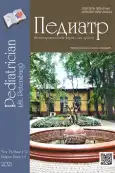Method for assessing the sublingual immunotherapy with house dust mite allergens effectiveness in children with bronchial asthma and allergic rhinitis
- 作者: Korostovtsev D.S.1, Trusova O.V.2, Kamaev A.V.2
-
隶属关系:
- Saint Petersburg State Pediatric Medical University
- First Saint Petersburg State Medical University named after I.I. acad. I.P. Pavlova
- 期: 卷 12, 编号 4 (2021)
- 页面: 35-43
- 栏目: Original studies
- URL: https://journals.rcsi.science/pediatr/article/view/90063
- DOI: https://doi.org/10.17816/PED12435-43
- ID: 90063
如何引用文章
详细
Background. For practical health care, tools for assessing the effect of allergen-specific immunotherapy have not been developed.
Aim. Approbation of the system for evaluating the effectiveness of sublingual immunotherapy with house dust mite allergens in patients with bronchial asthma with allergic rhinitis.
Materials and methods. 28 cases of sublingual immunotherapy treatment in patients aged 5 to 13 years, (8,6 [6,7; 11,6]) with control in pairs-copies matched by age, sex, and asthma severity were analyzed. Thus, the study included 56 patients. Patients in the control group did not receive sublingual immunotherapy. For 1 year before the start of treatment, and for the first year of treatment, the complex of clinical signs of bronchial asthma and allergic rhinitis, the need for basic and emergency therapy was assessed. The scores were calculated for symptoms, for drugs, and a total Score of symptoms and drugs.
Results. During 1 year of therapy, patients showed dynamics of the total Score from 23,32 ± 1,21 points to 16,21 ± 1,77 in the main group, and from 23,99 ± 1,2 points to 20.92 ± 2.09 in control group (p = 0.028). The greatest difference was found within medication domain.
Conclusion. The developed system for assessing the symptoms and the need for medications makes it possible to show the difference between groups of patients, in favor of the sublingual immunotherapy group. For 1 year of sublingual immunotherapy therapy, a difference in the total Score dynamics and the domain of drugs was revealed between the groups. The proposed assessment system is recommended for further investigation.
作者简介
D. Korostovtsev
Saint Petersburg State Pediatric Medical University
编辑信件的主要联系方式.
Email: dsk552@mail.ru
MD, Dr. Sci. (Med.), Professor, Department of Pediatrics them. Professor I.M. Vorontsov AF and DPO
俄罗斯联邦, Saint PetersburgO. Trusova
First Saint Petersburg State Medical University named after I.I. acad. I.P. Pavlova
Email: o-tru@mail.ru
MD, Cand. Sci. (Med.), Associate Professor, Department of Therapy with the Course on Allergy and Immunology
俄罗斯联邦, Saint PetersburgA. Kamaev
First Saint Petersburg State Medical University named after I.I. acad. I.P. Pavlova
Email: andykkam@mail.ru
MD, Cand. Sci. (Med.), Associate Professor, Department of General Practice
俄罗斯联邦, Saint Petersburg参考
- Allergicheskiy rinit 2020. Federal’nye klinicheskie rekomendatsii. Accessed 10.03.2021. Available at: https://raaci.ru/education/clinic_recomendations/ 471.html. (In Russ.)
- Bronchial’naya astma u detey 2017. Klinicheskie rekomendatsii. Available at: https://www.pediatr-russia.ru/information/klin-rek/deystvuyushchie-klinicheskie-rekomendatsii/Бронхиальная%20астма%20дети%20СПР%20рубрикатор.v2_2017_обновление.pdf (In Russ.)
- Trusova ОV, Kamaev АV, Мakarova IV. Patient dropouts from sublingual allergen specific immunotherapy with house dust mites. Solving a problem. Russian Journal of Allergy. 2020;17(2):53–60. (In Russ.) doi: 10.36691/RJA1364
- Agache I, Lau S, Akdis CA, et al. EAACI Guidelines on Allergen Immunotherapy: House dust mite-driven allergic asthma. Allergy. 2019;74(5):855–873. doi: 10.1111/all.13749
- Alvaro-Lozano M, Akdis CA, Akdis M, et al. EAACI Allergen Immunotherapy User’s Guide. Pediatr Allergy Immunol. 2020;31(25):1–101. doi: 10.1111/pai.13189
- Barberi S, Ciprandi G, Verduci E. Effect of high-dose sublingual immunotherapy on respiratory infections in children allergic to house dust mite. Asia Pac. Allergy. 2015;5(3):163–169. doi: 10.5415/apallergy.2015.5.3.163
- Bousquet J, Khaltaev N, Cruz AA, et al. Allergic Rhinitis and its Impact on Asthma (ARIA) 2008 update (in collaboration with the World Health Organization, GA(2)LEN and AllerGen). Allergy. 2008;63(Suppl 86):8–160. doi: 10.1111/j.1398–9995.2007.01620.x
- Dhami S, Kakourou A, Asamoah F, et al. Allergen immunotherapy for allergic asthma: A systematic review and meta-analysis. Allergy. 2017;72(12):1825–1848. doi: 10.1111/all.13208
- Global Initiative for Asthma. Global strategy for asthma management and prevention, 2018. Available at: http://www.ginasthma.org
- Häfner D, Reich K, Matricardi PM, et al. Prospective validation of ‘Allergy-Control-SCORETM’: a novel symptom–medication score for clinical trials. Allergy. 2011;66(5): 629–636. doi: 10.1111/j.1398-9995.2010.02531.x
- Occasi F, De Castro G, Zicari AM, et al. Sublingual immunotherapy in children and its potential beneficial collateral effect on respiratory tract infections. Curr Med Res Opin. 2019;31(5):939–941. doi: 10.1185/03007995.2015.1027182
- Pfaar O, Demoly P, Gerth van Wijk R, et al. Recommendations for the standardization of clinical outcomes used in allergen immunotherapy trials for allergic rhinoconjunctivitis: an EAACI Position Paper. Allergy. 2014;69(7):854–867. doi: 10.1111/all.12383
- Roberts G, Pfaar O, Akdis CA, et al. EAACI Guidelines on Allergen Immunotherapy: Allergic rhinoconjunctivitis. Allergy. 2018;73(4):765–798. doi: 10.1111/all.13317
- Shamji MH, Kappen JH, Akdis M, et al. Biomarkers for monitoring clinical efficacy of allergen immunotherapy for allergic rhinoconjunctivitis and allergic asthma: an EAACI position paper. Allergy. 2017;72(8): 1156–1173. doi: 10.1111/all.13138
补充文件







